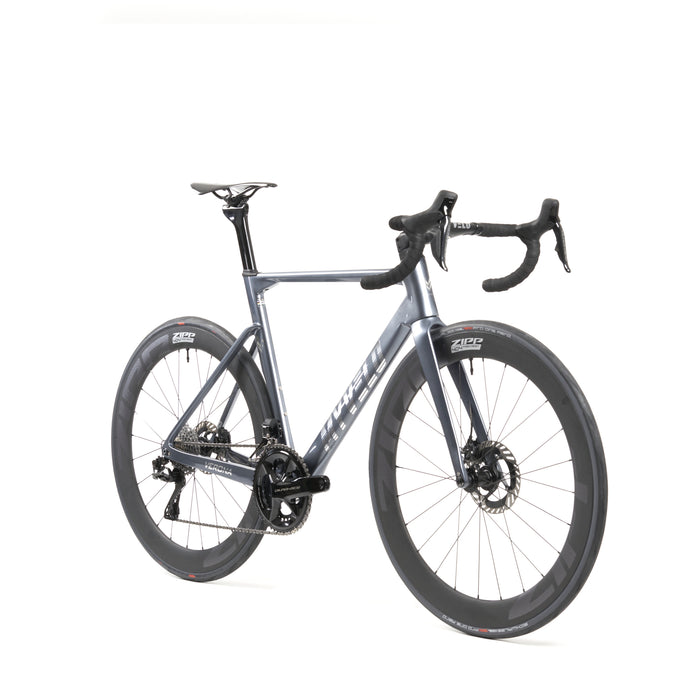
Verona road bike
incl. FREE shipping & free returns

For many, coffee is as much a part of their morning routine as a racing jersey is to their bike. But did you know that caffeine is much more than just a stimulant in endurance sports? Studies show that it can noticeably improve your performance – if used correctly. But as is so often the case, the devil is in the detail: dosage, timing, and individual tolerance determine whether caffeine is a real boost or an underestimated risk.
Von Vincent Augustin |
3 minutes read time

In this article you will learn:
how caffeine works in the body,
whether it really makes a difference in cycling,
how you use it specifically,
and where caution is required.
Caffeine is a psychoactive substance that primarily acts on the central nervous system. It blocks the so-called adenosine receptors in the brain – a natural "drowsiness signal." This makes you feel more alert, more focused, and less fatigued.
In cycling – whether during a race, training, or a Gran Fondo – this translates to increased endurance, better concentration, a delayed subjective perception of pain, and even improved fat burning. It's no wonder, then, that caffeine is one of the most widely used substances in professional and recreational sports.
The effects of caffeine in endurance sports have been well-researched. Here are some facts from studies:
Performance improvement of 2–5%: Numerous meta-analyses show that moderate doses (3–6 mg caffeine per kilogram of body weight) can improve endurance performance – regardless of training status.
Delayed fatigue: Caffeine reduces the subjective perceived exertion (RPE), which means you can ride at the limit for longer.
Improved fat burning: Caffeine increases the mobilization of free fatty acids in the blood, which can help preserve glycogen stores during longer rides.
More concentration: Caffeine can improve cognitive performance, especially in technical passages or during longer competitions.
Incidentally, the World Anti-Doping Agency (WADA) had caffeine on its list of banned substances until 2004 – today it is monitored but is permitted again.
You don't necessarily have to drink espresso to reap the benefits. There are many ways to consume caffeine:
| Caffeine source | Crowd | Caffeine content |
|---|---|---|
| Espresso (30 ml) | 1 cup | approx. 60–80 mg |
| Filter coffee (200 ml) | 1 cup | approx. 90–120 mg |
| Caffeine gel | 1 pack | 50–100 mg |
| Caffeine tablet | 1 piece | usually 100–200 mg |
| Cola / Energy Drink | 250 ml | approx. 30–80 mg |
Caffeine gels and tablets in particular have the advantage that you can dose them more precisely – and that they are more convenient to carry around than a coffee cup.
How much caffeine is appropriate depends on your body weight. The rule of thumb is:
3–6 mg caffeine per kg body weight
Example: At 70 kg body weight = 210–420 mg caffeine
Studies show that more than 6 mg/kg provides no additional benefit, but can increase side effects. Therefore, more is not better.
Caffeine takes effect approximately 30–60 minutes after ingestion. Its half-life in the body is approximately 4–6 hours, meaning it remains active for a relatively long time.
30 minutes before the session 1 coffee or a gel with caffeine
Particularly useful for intensive intervals or long rides
Preload: Take a targeted dose 60 minutes before the start
Mid-Race Boost: After 2–3 hours, e.g., during the break-in or towards the end
Caution: In long races, taking too early can lead to a "crash" when caffeine levels drop
Despite all its benefits, caffeine also has potential downsides:
Restlessness, nervousness
palpitations
Gastrointestinal problems
Sleep disorders
Increased urge to urinate (not ideal for long trips without a toilet)
Especially in high doses or in sensitive individuals, caffeine can do more harm than good. Sleep problems after late-afternoon consumption can also disrupt recovery — which can even reduce performance in the long run.
Tip: Always test caffeine during training, never for the first time during competition!
Some athletes swear by abstaining from caffeine for several days or even weeks before a competition in order to experience the effects "fresh." The research on this is ambiguous:
Some studies show a slightly increased effect after caffeine abstinence
Others see no significant difference
If you drink caffeine regularly and can handle it well, you don't necessarily have to give it up. If you want to try it, reduce your intake slowly to avoid withdrawal symptoms (e.g., headaches).
Caffeine is one of the most effective and legal aids in cycling. When dosed and used correctly, it can help you last longer, ride harder, and stay more focused. It's not a magic bullet—but it's a useful tool in everyday training and racing.
✅ 3–6 mg/kg body weight are effective
✅ Take 30–60 minutes before exercise
✅ Strategic dosage in competitions
✅ Test compatibility beforehand
✅ Be careful when consuming late (sleep!)
What do you think? Do you use caffeine during training or racing — or do you prefer to stay away from it?